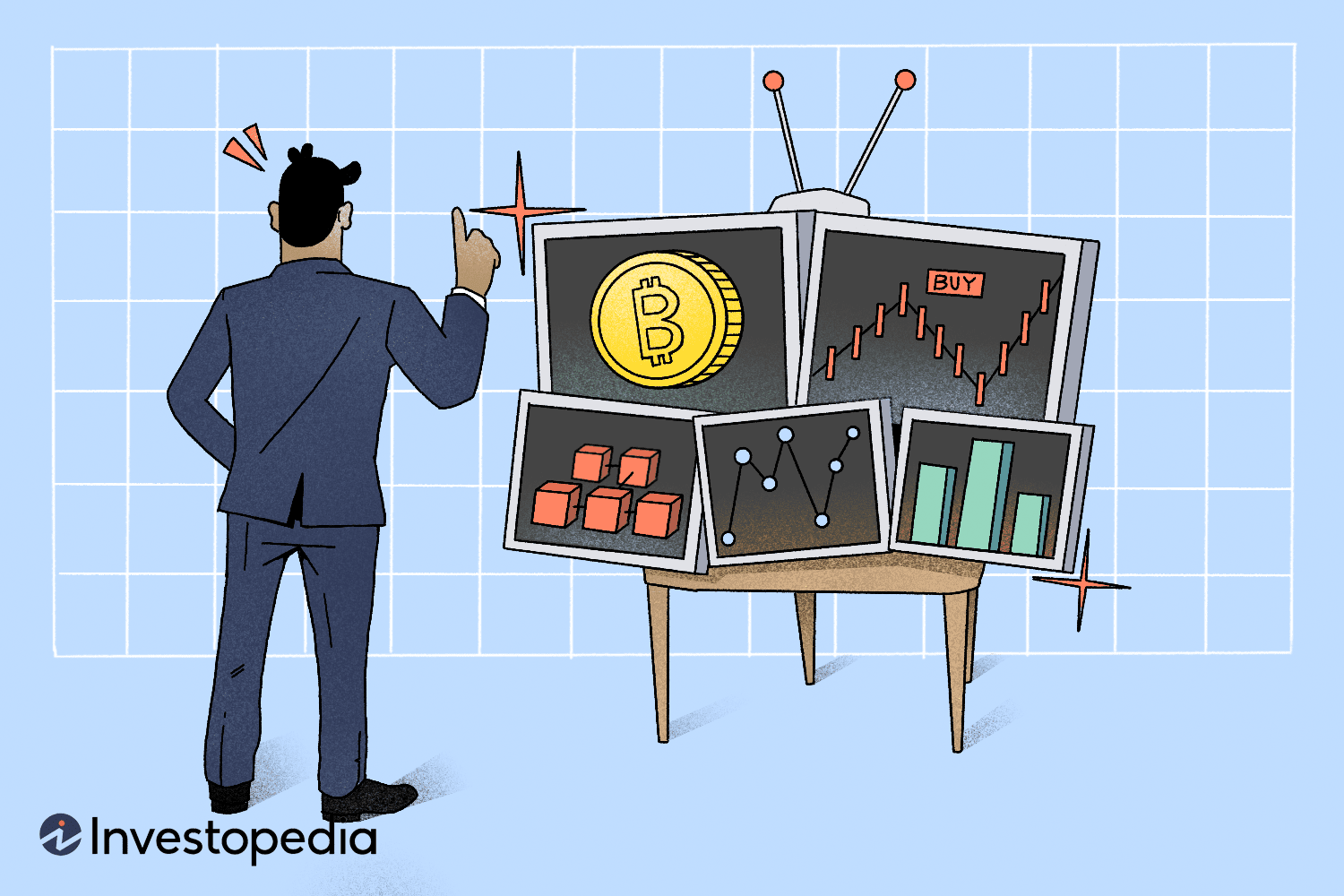| Bitcoin Returns | |||
|---|---|---|---|
| 1-Day | 1-Week | 1-Month | 1-Year |
| 0.36% | -5.464% | 10.86% | 122.86% |
Source: TradingView
How to Buy Bitcoin
Step 1: Choose a Crypto-Trading Service or Venue
Exchanges are a convenient option because they offer a breadth of features and more cryptocurrencies for trading. Exchanges also enable investors to buy, sell, and hold cryptocurrency and allow users to transfer crypto to their online wallet for safekeeping.
There are many cryptocurrency exchanges, but there are only two types—centralized and decentralized. Decentralized exchanges allow users to remain pseudo-anonymous and generally don’t require personal information. For certain demographics, including refugees or those living in countries with little to no infrastructure for government credit or banking, decentralized exchanges allow access to the global economy.
Popular exchanges in the U.S. and many other countries are centralized and follow laws that require users to submit identifying documentation. These exchanges include Coinbase, Kraken, Gemini, and Binance; they offer Bitcoin, a growing number of altcoins, and fiat exchange services.
When creating a cryptocurrency exchange account, use two-factor authentication and a long, unique password that includes a variety of lowercase and capital letters, special characters, and numbers.
Step 2: Connect Your Exchange to a Payment Option
Depending on the exchange, personal identification can be required, which may mean that you have to include a picture of a driver’s license or Social Security card, as well as information about your employer and source of funds. The process is largely the same as setting up a typical brokerage account.
At most centralized exchanges, you can connect your bank account directly or link it to a debit or credit card. Although you can use a credit card to purchase cryptocurrency, cryptocurrency price volatility could inflate the overall cost of purchasing a token when combined with a credit card’s interest charges. Bitcoin is legal in the U.S., but some banks may question or even stop deposits to crypto-related sites or exchanges without being notified of the activity by a customer.
Fees vary for deposits via a bank account, debit, or credit card, and exchanges also charge fees per transaction.
Step 3: Place an Order
Cryptocurrency exchanges have evolved and now mimic the same features as their traditional brokerage counterparts. Crypto exchanges offer several order types and ways to invest or trade. Almost all crypto exchanges offer both market and limit orders, and some also provide stop-loss orders.
Kraken offers the most order types, which include market, limit, stop-loss, stop-limit, take-profit, and take-profit limit orders.
Exchanges also offer ways to set up recurring investments, allowing clients to dollar-cost average their investments of choice. Coinbase, for example, lets users set daily, weekly, or monthly recurring purchases.
Step 4: Safe Storage
Cryptocurrency wallets are a place to store digital asset keys. Keeping crypto keys off an exchange and in a non-connected wallet (cold wallet) ensures that users have control over the keys. Investors can use the wallets offered by exchanges, but it’s not recommended for large or long-term cryptocurrency holdings.
Hot Wallets vs. Cold Wallets
Hot Wallets
Online wallets, also known as hot wallets, are apps on devices such as computers, phones, or tablets. These wallets generate the private keys to your coins on internet-connected devices.
Hot wallet holders who haven’t created enough security run the risk of losing funds to theft. Strong passwords, two-factor authentication, anti-virus programs, and safe internet browsing should be considered minimum requirements.
Hot wallets are best for small amounts of cryptocurrency or cryptocurrency that is actively trading on an exchange. Another use is like a checking account, only placing what you need for certain transactions in your hot wallet.
Cold Wallets
A cold wallet isn’t connected to the internet and is less likely to be compromised. These wallets store a user’s private keys on a device or item without a connection. Some come with software that allows investors to view their portfolios without putting their private keys at risk. Types of cold wallets are paper, hardware, or even metal stamped with private keys.
A paper wallet is simply a piece of paper with private keys written on it. Some people laminate these paper wallets and store them in safe deposit boxes at their bank or even in a safe in their home. There are websites and programs that can generate nifty, printable versions with quick response codes, but these should be avoided as they expose the private keys unnecessarily.
Cold wallets are the most secure way to store your bitcoin or other cryptocurrencies.
How to Buy Bitcoin With PayPal
You can buy Bitcoin through a payment processor like PayPal Holdings Inc. (PYPL). There are two ways to purchase Bitcoin using PayPal: You can connect your account to a debit card or bank account or use the balance of the PayPal account to buy cryptocurrencies from a third-party provider.
You may also use PayPal to directly buy four cryptocurrencies: Bitcoin, Ethereum, Litecoin, and Bitcoin Cash. Except for those who live in Hawaii, residents of all other states can use their existing PayPal accounts or set up a new one to buy bitcoin. Additionally, you can use your cryptocurrencies to purchase products and services through the “Checkout With Crypto” feature.
When you buy bitcoin directly from PayPal, it earns money from the crypto spread, or the difference between Bitcoin’s market price and its exchange rate with the U.S. dollar. For each purchase, PayPal also charges a transaction fee, which depends on the dollar amount purchased.
You can send crypto, including bitcoin, from PayPal to an external digital asset wallet that you own and control, or to one owned and controlled by another person like a friend or family member. To send your bitcoin outside of PayPal, you will need to provide the wallet address where you want to send the assets. If you are sending bitcoin, you must use a wallet that accepts it.
The social trading and multi-asset investment company eToro is among the few online traders that allow bitcoin purchases using PayPal.
How to Buy Bitcoin With a Credit Card
Using credit cards to buy bitcoin is similar to using debit cards or automated clearing house (ACH) transfers. However, not all exchanges allow you to buy Bitcoin with credit cards due to associated processing fees and the risk of fraud.
Credit card processing can add extra charges to these transactions. In addition to paying blockchain transaction fees, the exchange may pass on processing fees to the buyer. Credit card issuers treat bitcoin purchases as cash advances and charge hefty fees and interest rates on them.
For instance, American Express users will pay the current cash advance fee for such transactions, and the fee charged will vary by exchange. The credit card company also limits users to $1,000 worth of bitcoin purchases per month.
Alternative Ways to Buy Bitcoin
Bitcoin ATMs
Bitcoin ATMs act like in-person bitcoin exchanges. Individuals can insert cash into a machine and use it to purchase bitcoin, which gets transferred to their wallet. Bitcoin ATMs have become increasingly popular in recent years and are even available at the retail giant Walmart Inc. (WMT), among other places.
Bitcoin ATMs began requiring government-issued IDs in early 2020.
Two charges are associated with ATM bitcoin purchases: a purchase fee and a conversion fee for converting a fiat currency to bitcoin. Both fees are fairly steep compared with those of other options. For example, CoinHub charges a markup of 12.5% and a retailer fee of $4.95 above the Bitstamp spot rate.
P2P Exchanges
Some P2P exchange services provide a more direct connection between users. LocalBitcoins is an example of such an exchange. After creating an account, users can post requests to buy or sell bitcoin, including information about payment methods and prices.
Although P2P exchanges don’t offer the same anonymity as decentralized exchanges, they give users the chance to shop around for the best deal. Many of these exchanges also provide rating systems so that users can evaluate potential trade partners before transacting.
Mainstream Brokerages
Robinhood Markets Inc. (HOOD) is one exchange that offers crypto trading. It charges a 0% commission for cryptocurrency trades and purchases and makes money from the payment for order flow, passing its trading volume on to other trading platforms or brokerage firms. Robinhood has enabled trading on its platform for these cryptocurrencies, among others: Bitcoin, Bitcoin Cash, Litecoin, Ethereum, Dogecoin, and Ethereum Classic.
In contrast, you can trade thousands of cryptocurrencies on Coinbase, and beginning in 2022, traditional brokers like Fidelity Investments began to include bitcoin in 401(k) accounts.
Bitcoin and other cryptocurrency investments are not protected by insurance from the Securities Investor Protection Corp. (SIPC). At regular brokerages, the agency protects against the loss of securities and cash in brokerage accounts containing up to $500,000, with a $250,000 cash limit. Cryptocurrency exchanges such as Coinbase have crime insurance to protect their infrastructure against hacks. But that insurance doesn’t protect individual customers from password theft.
How to Sell Bitcoin
You can sell bitcoin at the same venues where you purchased the cryptocurrency, such as cryptocurrency exchanges and P2P platforms. Typically, the process of selling bitcoin on these platforms is similar to the process of buying it.
Most cryptocurrency exchanges charge a percentage of the crypto sale amount as fees. For example, Coinbase says it may charge a fee when a customer cashes out their crypto, depending on the payment method selected.
Exchanges generally have daily and monthly withdrawal limits. Therefore, cash from a large sale may not be immediately available to the trader. However, with Coinbase, for example, there is no limit on the amount of cryptocurrency you can sell.
How Do Beginners Buy Bitcoin?
The best way for a beginner to purchase bitcoin is to create an account on a reputable and regulated exchange, fund it, and make a purchase.
How Can I Buy $100 Worth of Bitcoin?
Regulated exchanges are the safest way to purchase bitcoin, but you can also buy some at Bitcoin ATMs or through PayPal.
What If I Invest $100 in Bitcoin Today?
It is possible that $100 in bitcoin today might turn into $200 or more in the future, but it is just as likely that it will turn into $1. Bitcoin is very volatile, so you should consider your financial circumstances before investing to determine if you can afford to lose the money you invest.
The Bottom Line
Buying bitcoin can seem complicated if you haven’t done it, but it’s relatively simple. It just requires an account at a service or an exchange and a way to store your purchases safely.
To buy bitcoin, you must select an appropriate service or venue, connect with a payment method, place an order, and ensure stable storage for purchased cryptocurrency. Each of these steps requires research and a careful assessment of the pros and cons of the relevant service. Bitcoin is available at bitcoin ATMs or from payment services like PayPal and mainstream brokerage firms like Robinhood or Coinbase.










